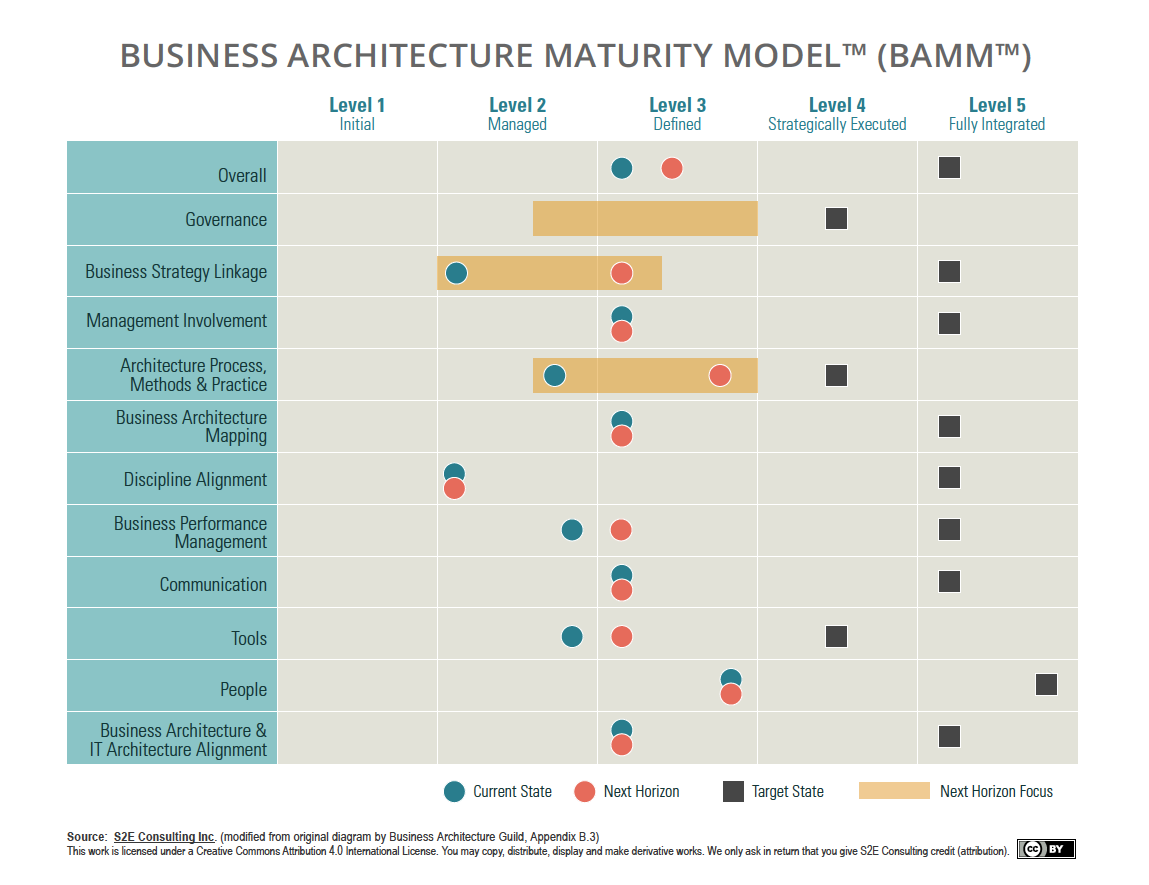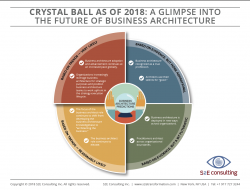 We are happy to share that S2E Founder and BA Guild Co-Founder Whynde Kuehn summitted Aconcagua in Argentina in the afternoon on January 28, 2018. At 22,841 feet (6,960 meters), it is the tallest mountain in the world outside of the Himalayas. And, she brought a flag with the BA Guild logo along with her to the top, giving a new meaning to “Business Architecture Summit!”
We are happy to share that S2E Founder and BA Guild Co-Founder Whynde Kuehn summitted Aconcagua in Argentina in the afternoon on January 28, 2018. At 22,841 feet (6,960 meters), it is the tallest mountain in the world outside of the Himalayas. And, she brought a flag with the BA Guild logo along with her to the top, giving a new meaning to “Business Architecture Summit!”
Charting The Course: Maturity-Driven Business Architecture Practice Planning
![]() Now that we’re inspired about the future of business architecture and architects after the last StraightTalk post, it’s a good time to do a little planning for our own business architecture practice. StraightTalk Post No. 20 here will talk about how to assess the maturity of your practice and plan for its advancement.
Now that we’re inspired about the future of business architecture and architects after the last StraightTalk post, it’s a good time to do a little planning for our own business architecture practice. StraightTalk Post No. 20 here will talk about how to assess the maturity of your practice and plan for its advancement.
Start from the beginning. What is a maturity assessment?
A business architecture maturity assessment measures the progress of an organization’s business architecture practice across various categories, against an objective standard.
It does not measure the maturity of the organization’s capabilities, but rather the key aspects of a business architecture function.
Is there an industry standard for this?
Yep, it’s called the Business Architecture Maturity ModelTM or BAMMTM for short. (P.S. If you just yelled BAM! to yourself, that seems to be a normal reaction.)
Like other maturity models, the BAMMTM includes a set of categories and levels. The categories cover all topics related to business architecture (e.g. knowledgebase, governance and tools), business architects (e.g. training and role) and the practice itself (e.g. executive engagement, communication and integration).
There are five levels of maturity in the BAMM.TM As a practice progresses towards level 5, it becomes more strategic, more embedded into the fabric of the organization, and provides more value.
Just reading through the BAMMTM is a helpful exercise as it will help you to understand what a successful and mature practice looks like.
Who should do the business architecture maturity assessment?
When you’re getting started, it may be beneficial to have an independent third party do the first maturity assessment to help you learn the tool and make sure you get an accurate baseline. From there, you can continue to get third party assessments annually or on a less frequent basis, but regularly enough to make sure your results remain unbiased and aligned with the most recent thought.
Once you have the hang of the maturity assessment, the business architecture team can complete the assessment considering the guidance above. As your practice continues to mature, you can expand the assessment to include the voice of your partners (e.g. IT architects and other teams) and stakeholders (e.g. business leaders).
How do we do the business architecture maturity assessment?
- Step One. Bring the right people together in a conversation and discuss your business architecture practice’s progress category by category. The criteria described in the BAMMTM will help you to determine which level of maturity you are currently at for each category. As your practice matures, you can do more advanced things like collect feedback through a survey.
- Step Two. Document, review and publish the results accordingly.
- Step Three. Repeat each year. A good time to perform the maturity assessment is in the last quarter of the year, so that it can inform the priorities and plans for your business architecture practice in the following year.
Okay, so what do we do with the maturity assessment when it is done?
A few things:
- Share your results – For example, your leader and other stakeholders may be interested to know how the business architecture practice is progressing. Reality check: When you interpret your results, go easy on yourself. Keep in mind that your business architecture practice will always add value, it just adds more value as it becomes more mature. Also, this is a journey and it can take a large organization a number of years to really mature. Reaching even a level 3 maturity in a large organization may take some time and investment.
- Determine what you would like to improve next – For each category, discuss, determine and document both your long-term maturity goal (which may not be a level 5 for everything) and your next horizon maturity goal.
- Create a roadmap to mature your practice over the next horizon – Based on the gaps in each category between your current level of maturity and your next horizon maturity goal, identify the activities you need to perform in order to close each gap. List these activities on a roadmap for the next year or whatever timeframe makes the best sense.
Here’s a diagram to help visualize all of this. Here you can see the BAMMTM categories and levels, as well as a sample assessment of current state, next horizon and long-term maturity levels.
Tell me more about the business architecture practice roadmap.
The roadmap typically includes any activities related to:
- Developing your business architecture knowledgebase
- Establishing and maturing your practice (e.g. defining the business architect role and organizational structure, training, selecting and implementing a tool, establishing governance, integrating with other teams, etc.)
- Planned applications for using business architecture
You can create a high level visual for communication purposes and then create a work plan with more detailed activities, if necessary.
P.S. If you want to refresh on all of the things that go into establishing a practice that you should consider, refer back to Post No. 4, Let’s Get This Party Started.
What is the value of creating the business architecture practice roadmap?
Creating a business architecture practice roadmap is a best practice which:
- Encourages intentional focus and investment for maturing your practice
- Provides you with a way to communicate what you are working on and the resources it will require
- Facilitates sharing and alignment of roadmaps and activities with other teams (e.g. IT architecture, customer experience, etc.)
Makes sense. Anything else?
Whether your organization has a new business architecture practice or a mature one, assessing your business architecture maturity and creating an intentional practice roadmap is always valuable and relevant.
Happy scoring and best of luck on the journey!
More Good Stuff
- Bending Trends With Business Architecture – Humana (March 2017)
- Using Business Architecture to Build a Better Boeing – Boeing (March 2017)
- Driving Value Through Business Architecture Governance – General Motors (March 2016)
Crystal Ball as of 2018: Business Architecture Now + A Glimpse Into the Future
![]() Happy New Year!
Happy New Year!
We’re starting this promising new year with a look at where we’re at with business architecture and where we’re going in the future to inspire those New Year’s resolutions.
(This is based on extensive global engagement with and visibility to business architecture practitioners, organizations applying business architecture, and various industry groups.)
Why is this important?
It’s a great time to reflect. Understanding the state of the broader context within which we all work provides a good reference point for comparing our own ideas and progress as individual practitioners and organizations practicing business architecture. And, it’s just important to remember that you’re not alone, but rather part of a rich global community—and we all have much in common.
It’s also a great time to dream and plan. The business architecture discipline is continually growing and evolving, and so knowing where it’s headed can help you to better steer your career and your organization’s business architecture practice journey.
Okay, so what’s the state of business architecture now?
Business architecture has proven that it is here, and here to stay.
In a nutshell (because this is StraightTalk), here’s where we’re at:
- More organizations are practicing business architecture (in various stages of maturity), in an increasing number of geographies and industries.
- More organizations are using business architecture strategically and positioning it in the business and upfront in the strategy lifecycle.
- More practitioners are pursuing business architecture as a career, getting certified, forming local communities, and pushing the role to new heights.
- More progress is being made by industry organizations individually and collectively to formalize and advance the business architecture discipline and role.
- More recognition and credence is given to business architecture by research analysts, tool vendors, consultants and other players in the market.
Note: all of the “more” above is an indication that growth in this discipline is increasing on every front—and the pace is speeding up.
P.S. It’s a fun debate with your friends to discuss whether business architecture has crossed the chasm yet between early adopters and an early majority on the innovation curve. What do you think?
What might the future hold?
While the journey may not always be easy, based on current trends and evidence, here’s where we’re going and it’s going to be a fun ride. (Note: Some of these predictions are a number of years out.)
- Business architecture adoption and advancement continues at an increased pace globally. More organizations using business architecture, more demand for business practitioners, more adoption by executives and academic organizations, more formalization of the discipline, more expansion of the market.
- Organizations increasingly leverage business architecture for strategic purposes and position business architecture teams to work upfront in the strategy execution lifecycle. Business architects become the focal point for strategy translation and prioritization, as well as key leaders in business transformations and other change initiatives. The trend of business architects working upstream in the strategy execution lifecycle continues as well as the trend of business architecture teams reporting to a leader within the business. Business architecture becomes embedded into the fabric of organizations and “just the way business is done.” Those who adopted it earlier in the game enjoy a competitive advantage.
- The focus of the business architect role continues to shift from developing the business architecture knowledgebase to “architecting the business.” With the continued availability and maturation of industry reference models, creating the business architecture knowledgebase can be greatly accelerated. In the future, this may even “commoditize” some of the mapping skills needed by an architect. Architects focus where the real value is: architecting the business and applying the knowledgebase in support of various business scenarios.
- The business architect role continues to elevate. Based on the two predictions above, the business architect role continues to increase in the responsibility and respect it receives, the talent it draws, and its desirability as a career.
- Business architecture is deployed in new ways across organizations. As the adoption and need for business architecture increases, organizations get creative on how to scale and deploy it, such as business architects working as part of a cross-functional design team or aspects of business architecture becoming part of multiple peoples’ roles.
- Business architects architect across organizational boundaries. Architects work together across organizational boundaries to architect towards common goals. This type of collaboration is likely in our highly connected world, and will be essential to tackle the major opportunities and challenges that lie ahead of us.
- Architecture becomes a true profession. As business and IT architecture industry organizations come together and create a common foundation with specializations by discipline, a true architecture profession emerges with characteristics such as accountability, institutional preparation and ethical constraints.
- Architects use their talents for “good.” By nature, architects are passionate people who want to make a difference. The early results of our recent Architecting For Good survey illustrate this in a big way. Business architects use their rare talents to help non-profits, churches, start-up organizations or other social initiatives to better achieve their missions. Maybe it even becomes a movement. If you haven’t done so, please take our Architecting for Good survey. We value your ideas and want to hear about your passions.
Here’s a handy diagram summarizing these predictions for you to download and share.
What does this all mean to me?
If you’re responsible for business architecture in your organization, recognize that business architecture is being positioned strategically now, as it should be. This will provide you with the most value and likely be a missing piece to solving some of your challenges around strategy translation, prioritization, implementing major transformations, simplification and cross-business unit collaboration. Invest in your business architects and hang onto them, as they will become even more demanded in the market. Align with industry methods per the BIZBOK® Guide. And if you haven’t already, start adopting business architecture now to gain competitive advantage (or at least not to be behind later).
If you’re a business architecture practitioner, your value is in applying business architecture. Learn how to create the business architecture knowledgebase and do so for your organization as quickly as possible. Then move on to putting it in action. Strategic, practical and value-add is winning over academic approaches and long efforts to create knowledgebases. Get knees deep into the business and solve problems. Remember that we are a part of a broader ecosystem from strategy to execution, and we partner with many other teams to do that and can help to make them more successful.
If you’re an architecture industry organization, hats off to you in all that you’ve done to formalize and advance the business / enterprise architecture discipline. Keep going, keep collaborating and speed up. We need to be there for this community of architecture practitioners and organizations, and keep up with the new momentum that the discipline is experiencing.
And for all of us, a call to action — business architecture has somewhat reinvented itself to have its own identity outside of enterprise architecture, where it has become much closer to the business, and to some extent, this has contributed to its increasing success. This is very positive, but in some cases, this has seemed to create a separation now between some business and IT architecture teams. There is an opportunity for us to come together as architects and build strong partnerships, especially as the lines between business and technology blur. This will only lead to better service to our organizations—and our own careers.
We think that business architecture is one of the most promising, exciting and important disciplines right now. For those who want to be challenged and make a meaningful difference to their organizations and our world, you’ve come to the right place. Now dream big and set some goals for the year!
More good stuff
The Business Architecture Quick Guide (Business Architecture Guild®): Drum roll, please…The Business Architecture Quick Guidebook is now available on Amazon and Barnes and Noble. Finally, a short book (less than 100 pages) that is BIZBOK® Guide aligned which you can read and share with your leaders and others interested in the discipline. Happy New Year.
The Business Architecture Team (S2E White Paper): Check out our newest white paper which answers many of the most frequently asked questions about designing a business architecture team and the business architect role itself. There’s loads of material in here to help you shape the future of your career (e.g. business architect role description and competencies) and your organization’s practice.
One Trait Leaders (and Designers) Have In Common (Inc.): {Spoiler Alert} How optimism makes great leaders, designers and architects. What an inspiring theme for the year.
Your Life In Weeks (Wait But Why): While we’re planning for the future, here is one of the most powerful visuals to help us make the most of our precious time on this planet.
The Power of Optimism (TED Talk): A talk from Bert Jacobs on optimism as a strategy for life. Life is good.


